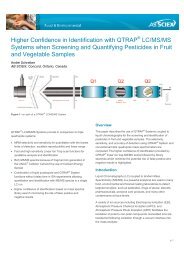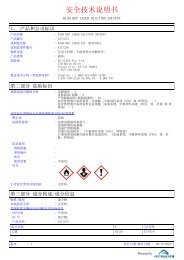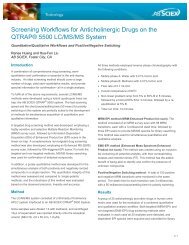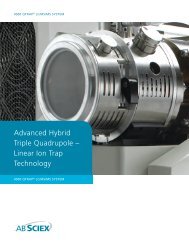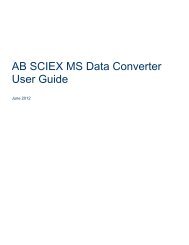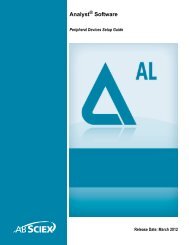Analyst Software Reference Guide - AB Sciex
Analyst Software Reference Guide - AB Sciex
Analyst Software Reference Guide - AB Sciex
- No tags were found...
Create successful ePaper yourself
Turn your PDF publications into a flip-book with our unique Google optimized e-Paper software.
<strong>Software</strong> <strong>Reference</strong> <strong>Guide</strong>WizardsThere are two available method-creation wizards: the Standard Quantitation wizard and theAutomatic Quantitation wizard. Both allow you to select the batch or batches to be quantified,create or select a quantitation method, and then integrate the sample data.The difference between the two is the type of method you create. The standard wizard creates astandard method, while the automatic wizard creating methods. You do not verify the peaks aspart of the method creation (you can still review the peaks after integration has taken place).There is only one common occasion for which you would not need to verify the peaks: when youare doing quantitation simply to integrate, not to find concentrations. You might want to do this,for example, if you have a batch that contains different compounds in every sample, or when themass is not the same from sample to sample. If this is the case, use the automatic wizard.Otherwise, to perform quantitation, use the standard wizard.Use the Standard Quantitation wizard after you have acquired your sample and you want to:• Choose a representative sample.• Select analyte and internal standard peaks.• Adjust peak-finding and integration parameters.• Review peaks during method creation.• Select calibration.Use the Automatic Quantitation wizard to select a batch, create a method (without peakconfirmation), and then integrate the sample data. This wizard is quicker than the Standardwizard and does not require that the masses scanned be the same for all samples. It does not,however, allow you to select an internal standard—all ions are treated as analytes.Use the Automatic Quantitation wizard after you have acquired your sample and you:• Want to select calibration.• Do not want to adjust peak-finding and integration parameters.• Do not want to select analyte peak names.• Do not want any internal standards.• Do not want to review peaks during method creation, or you have differentcompounds in every sample.When you are only integrating peaks, you do not need to verify them as no concentrationcalculation is required. In this case, use the Automatic quantitation method creation, which allowsyou to review the peaks after integration has taken place.Finding Peaks Using an Automatic MethodThe software uses the standard peak-detection process, with the following exceptions:• It uses the bunching factor and the number of smooths (from the wizard) as is.• It calculates the expected retention time and noise and area thresholds separatelyfor every peak.Release Date: August 2011 23



